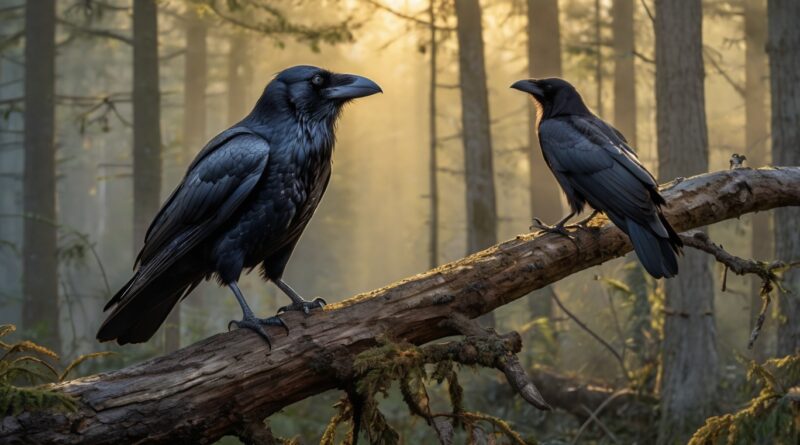Crow vs. Raven: Unraveling the Mysteries of These Intelligent Birds
Step into the world of avian intelligence and soar with the Crow and the Raven – two of the most enigmatic and intelligent birds in the animal kingdom. In this captivating article, we unravel the mysteries surrounding these avian wonders, shining a light on their remarkable abilities and behaviors.
Both the Crow and the Raven have fascinated and intrigued humans for centuries. Known for their high intelligence levels, they display incredible problem-solving skills, create and use tools, and even demonstrate a form of communication.
But what sets them apart? While similar in appearance, there are distinctive features that differentiate these feathered creatures. With their larger size and deep, resonating calls, Ravens exude an air of mystery, while Crows are known for their adaptability and playful nature.
Join us on a flight through the fascinating world of these intelligent birds as we explore their intricate social dynamics, their role in mythology and folklore, their remarkable memory, and much more. Whether you’re a bird enthusiast or simply intrigued by the wonders of nature, this article will leave you spellbound by the intelligence and beauty of these avian marvels.
Physical characteristics and differences between crows and ravens
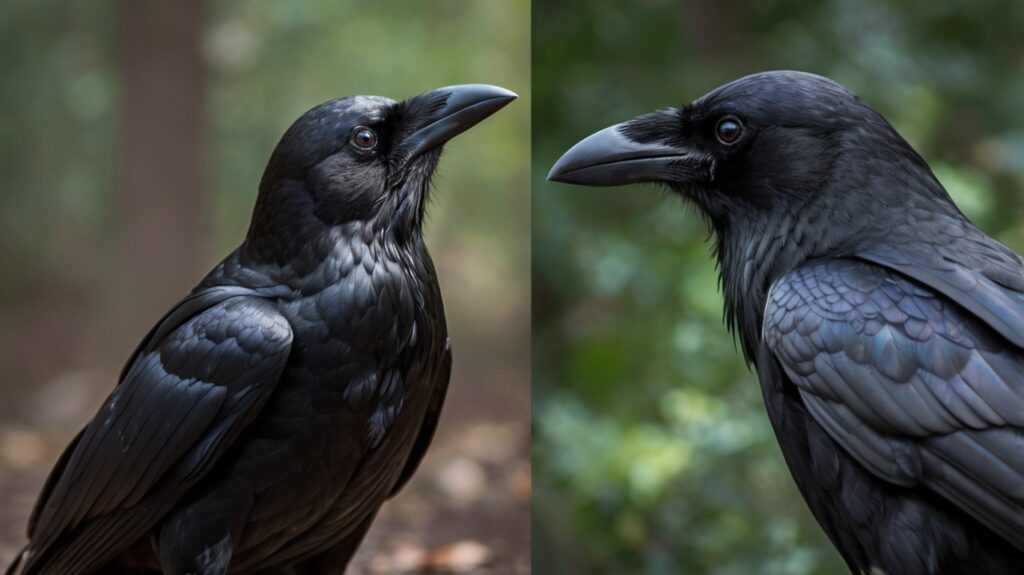
Crows and ravens, while often mistaken for one another due to their similar coloration and size, exhibit distinct physical characteristics that set them apart. One of the most noticeable differences lies in their size; ravens are significantly larger than crows, with a wingspan that can exceed four feet, compared to the crow’s wingspan of about two and a half feet. This size difference is accompanied by a more robust and heavier bill in ravens, which is curved and broader at the base. In contrast, crows possess a more slender and straighter beak. Observing these traits can greatly assist in identifying these two intelligent birds in the wild.
Another key differentiator is the shape of their tails. When in flight, a raven’s tail appears wedge-shaped or diamond-shaped, whereas a crow’s tail is more fan-shaped. This tail distinction can be particularly helpful when observing these birds from a distance. Furthermore, the feathers of a raven often display a more iridescent sheen, reflecting purples and blues when the light hits them just right. Crows, on the other hand, tend to have a more uniform and matte black appearance. These subtle variations in plumage contribute to the overall mystique surrounding these birds, enhancing their allure in the eyes of bird watchers and nature enthusiasts alike.
Additionally, their vocalizations are another aspect where crows and ravens diverge. Ravens produce a deep, resonant call that can sound like a croak, while crows emit a higher-pitched caw that is more commonly recognized. Their calls not only serve as communication but also play a role in their social interactions. Understanding these physical traits and vocal differences is essential for anyone interested in observing these remarkable birds in their natural habitats, as it adds depth to the experience of watching them soar through the skies.
Behavioral traits of crows and ravens
Crows and ravens both display a fascinating range of behaviors that reflect their high intelligence and adaptability. One notable trait is their social structure; both species are known to form complex social networks. Crows are often seen in larger groups, sometimes numbering in the hundreds, especially during the winter months. These gatherings allow them to share information about food sources and potential threats. Ravens, while also social, tend to be more solitary or found in pairs, particularly during breeding season. Their interactions can involve intricate aerial displays, showcasing their agility and strength as they engage in playful and competitive behaviors.

Playfulness is a prominent behavioral trait observed in both crows and ravens. They are known to engage in play, not only with one another but also with objects in their environment. This playful behavior can include sliding down snow-covered roofs, playing catch with other birds, or even manipulating objects for their amusement. Such activities are not merely for fun; they serve as a way for these birds to hone their problem-solving skills and develop social bonds. Observing these playful antics can be a delightful experience, giving insight into their vibrant personalities.
In addition to their social behaviors, crows and ravens exhibit remarkable problem-solving abilities in their daily activities. They are adept at using tools, a skill that highlights their cognitive capabilities. For instance, crows have been observed using sticks to extract insects from tree bark, while ravens have been seen dropping hard-shelled nuts onto roads to crack them open, taking advantage of passing cars. This innovative approach to obtaining food demonstrates their ability to adapt and manipulate their surroundings, making them two of the most intelligent birds in the animal kingdom. Their behaviors reflect a blend of adaptability, social interaction, and cleverness, captivating those who take the time to observe them in the wild.
Intelligence and problem-solving abilities of crows and ravens
The intelligence of crows and ravens is often regarded as among the highest in the avian world, rivaling that of primates. Researchers have conducted numerous studies to unravel the cognitive abilities of these birds, revealing their exceptional problem-solving skills. One fascinating experiment involved presenting crows with a series of tasks that required multiple steps to obtain a reward. These tasks demonstrated the birds’ ability to plan ahead, showing an understanding of cause and effect. For instance, crows were able to figure out how to use a sequence of tools in the correct order to retrieve a piece of food, showcasing their advanced cognitive processing.
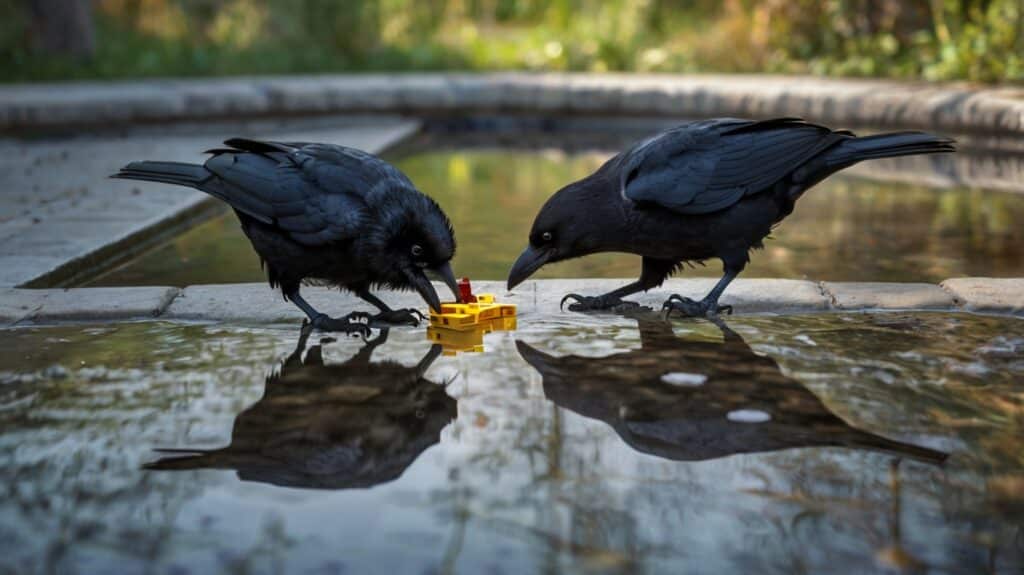
Ravens, too, have displayed remarkable intelligence in various studies. They have been observed engaging in complex social behaviors, such as cooperating with one another to achieve a common goal. This cooperation can be seen in their hunting strategies, where they work together to distract and catch prey. Furthermore, ravens have a keen ability to recognize individual human faces, which allows them to differentiate between friendly and threatening individuals. This skill not only highlights their intelligence but also underscores their capacity to learn from experiences and adapt their behaviors accordingly.
Another intriguing aspect of their intelligence is their impressive memory. Both crows and ravens can remember specific locations where they have hidden food, often returning to these caches long after they were stored. They also possess the ability to remember individual humans and their interactions, which can influence their future behavior towards those people. This remarkable memory is crucial for survival, especially in environments where food resources may be scarce. The combination of problem-solving abilities, social intelligence, and exceptional memory makes crows and ravens a fascinating subject of study for ornithologists and animal behaviorists alike.
Cultural significance and symbolism of crows and ravens

Crows and ravens have held significant cultural importance throughout history, appearing in various mythologies, folklore, and even modern media. In many cultures, these birds are often seen as symbols of intelligence and adaptability. For instance, in Native American cultures, ravens are frequently depicted as tricksters and creators, embodying duality and the balance of life and death. Their cleverness and resourcefulness have made them prominent figures in stories and legends, where they often play pivotal roles in shaping the world.
In contrast, crows have been associated with omens and death in some cultures, often seen as harbingers of doom. This symbolism can be traced back to their scavenging habits, which led to associations with battlefields and decay. However, despite this darker image, crows are also celebrated for their intelligence and communal behavior. In many cultures, they are viewed as protectors or messengers, bridging the gap between the earthly and the spiritual realms. This duality in symbolism adds richness to the narrative surrounding these birds, illustrating the complexity of human perceptions of nature.
Modern media has further perpetuated the mystique of crows and ravens, with their appearances in literature, films, and art. From Edgar Allan Poe’s “The Raven,” which explores themes of loss and despair, to the iconic portrayal of crows in various fantasy genres, these birds continue to captivate the imagination of audiences worldwide. Their enigmatic nature and striking appearance allow them to serve as powerful symbols, embodying various themes and emotions that resonate with the human experience. Thus, crows and ravens remain integral to cultural narratives, reflecting our fascination with their intelligence and the mysteries of the natural world.
Myths and folklore surrounding crows and ravens
The myths and folklore surrounding crows and ravens are as varied as the cultures that celebrate them. In many traditions, these birds are imbued with supernatural qualities, often viewed as messengers from the spirit world. In Norse mythology, for example, Odin, the chief god, is accompanied by two ravens named Huginn (thought) and Muninn (memory), who fly throughout the world and bring back information. This association with knowledge and foresight highlights the revered status of ravens in ancient cultures, often linking them to wisdom and prophecy.
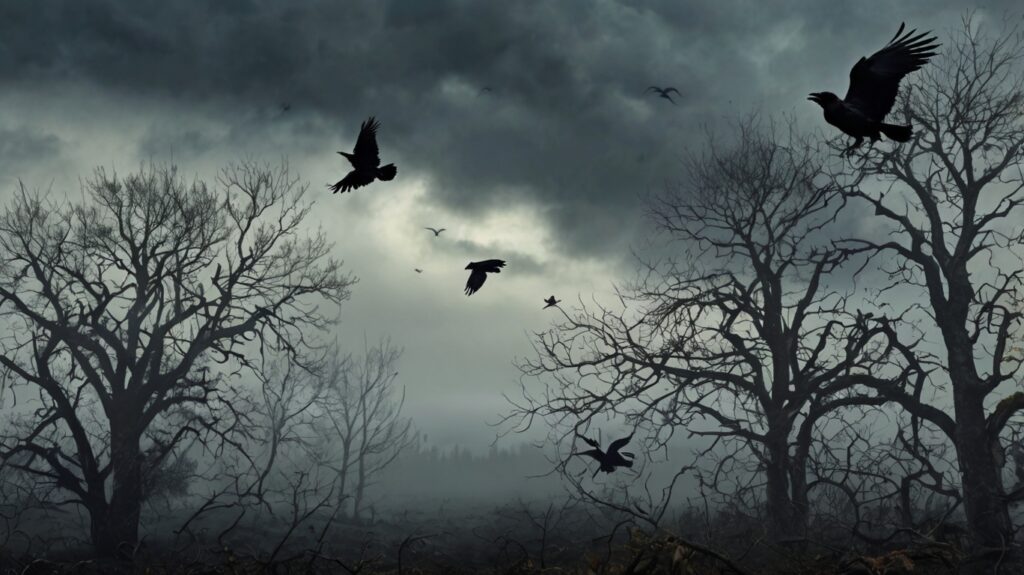
Conversely, in some cultures, crows are viewed with suspicion and fear. They are often portrayed as omens of misfortune or death, likely stemming from their scavenging habits and association with battlefields. This negative perception has led to numerous tales where crows are seen as harbingers of bad news or misfortune. However, even within these darker narratives, there is often an underlying acknowledgment of their intelligence and cunning, further complicating their role in folklore.
In contemporary storytelling, crows and ravens continue to capture the imagination, often serving as symbols of mystery and transformation. They appear in various forms of media, from literature to film, where they embody themes of change, duality, and the unknown. Their ability to navigate both the earthly and spiritual realms makes them compelling characters in stories that explore the human experience. As we delve deeper into the myths and legends surrounding these birds, we uncover a rich tapestry of beliefs that reflect humanity’s complex relationship with nature and the avian world.
Interesting facts about crows and ravens
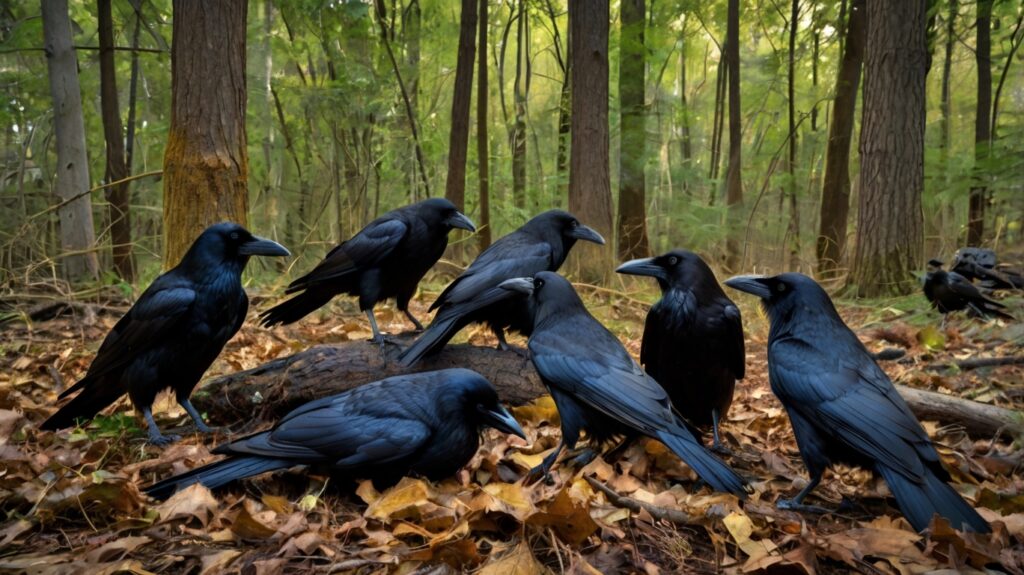
Crows and ravens are not only fascinating in their behaviors and cultural significance but also boast an array of interesting facts that highlight their unique traits. One remarkable aspect is their social intelligence. Crows have been observed engaging in what can be described as funerary behaviors, where they gather around deceased members of their species. This gathering is believed to be a way for the birds to learn about potential dangers and to reinforce social bonds within their community. Such behaviors indicate a level of emotional awareness that is rarely seen in other animals.
Another intriguing fact is their exceptional adaptability. Both crows and ravens have successfully thrived in urban environments, demonstrating their ability to exploit new resources and adjust to changing landscapes. This adaptability is evident in their diet, which can range from insects and small animals to human food scraps. Their resourcefulness in urban settings has allowed them to coexist with humans, often leading to fascinating interactions that showcase their intelligence.
Moreover, these birds possess impressive vocal abilities. Ravens, in particular, are known for their diverse range of sounds, which can include imitations of other species, human speech, and a variety of calls that convey different meanings. Crows, while not as vocally versatile, also have a range of calls used for communication within their groups. This vocal complexity adds another layer to their intelligence, as they can convey nuanced messages to one another. With their remarkable adaptability, social intelligence, and vocal prowess, crows and ravens continue to captivate and intrigue those who take the time to observe them in their natural habitats.
Conservation efforts and challenges faced by crows and ravens
Despite their resilience and adaptability, crows and ravens face various conservation challenges that threaten their populations and habitats. Urbanization poses a significant threat, as expanding cities and infrastructure can lead to habitat destruction and fragmentation. While these birds have adapted to urban living, the loss of natural habitats can still impact their food sources and nesting sites. Additionally, pollution and pesticide use can have detrimental effects on their health, leading to declines in population numbers over time.
Another challenge is the persecution of crows and ravens due to their perceived negative impact on agriculture and livestock. Farmers sometimes view these birds as pests, particularly when they feed on crops or raid nests. This perception can lead to measures aimed at reducing their populations, which can disrupt local ecosystems and ultimately harm both the birds and the environment. Efforts to educate the public about the ecological benefits of these birds, such as their role in pest control and scavenging, are crucial for fostering coexistence between humans and these intelligent avians.
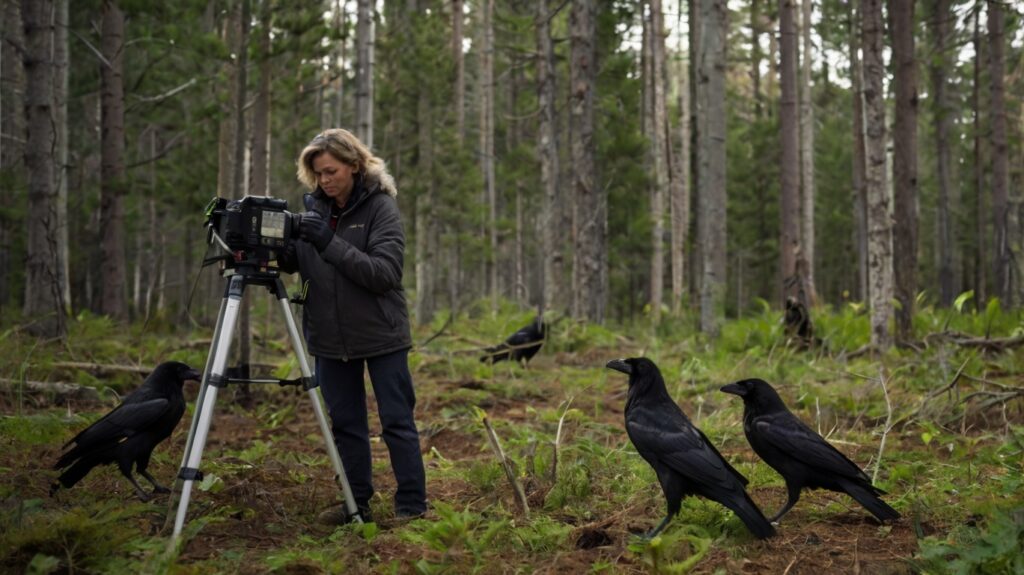
Conservation organizations are working to address these challenges through habitat preservation, public education, and research initiatives. By promoting awareness of the ecological importance of crows and ravens, these efforts aim to foster a greater appreciation for these birds and encourage sustainable practices that protect their habitats. As we continue to learn more about their behaviors and roles within ecosystems, it becomes increasingly important to advocate for their conservation and ensure that future generations can appreciate the intelligence and beauty of these remarkable birds.
Observing and attracting crows and ravens in your area
For bird enthusiasts and nature lovers, observing crows and ravens in their natural habitats can be a rewarding experience. To increase your chances of spotting these intelligent birds, consider creating an inviting environment in your backyard. Providing food sources such as unsalted peanuts, dog food, or bird seed can attract both crows and ravens, encouraging them to visit regularly. These birds are opportunistic feeders and will appreciate a reliable food source, especially during the colder months when natural food may be scarce.

In addition to food, offering natural shelter can make your yard more appealing to crows and ravens. Planting native trees and shrubs can provide nesting sites and roosting areas, creating a safe space for them to rest and socialize. Crows and ravens are social creatures and often prefer to gather in areas where they feel secure. By providing a suitable environment, you can enhance your chances of observing their fascinating behaviors up close.
When observing these birds, patience and stealth are key. Crows and ravens are highly intelligent and can be wary of human presence. Finding a quiet spot where you can sit and watch them interact with their environment can yield exciting results. Whether it’s witnessing their playful antics, observing their social interactions, or marveling at their problem-solving skills, spending time in the company of these remarkable birds can deepen your appreciation for their intelligence and beauty.
Conclusion and appreciation of the fascinating nature of these intelligent birds
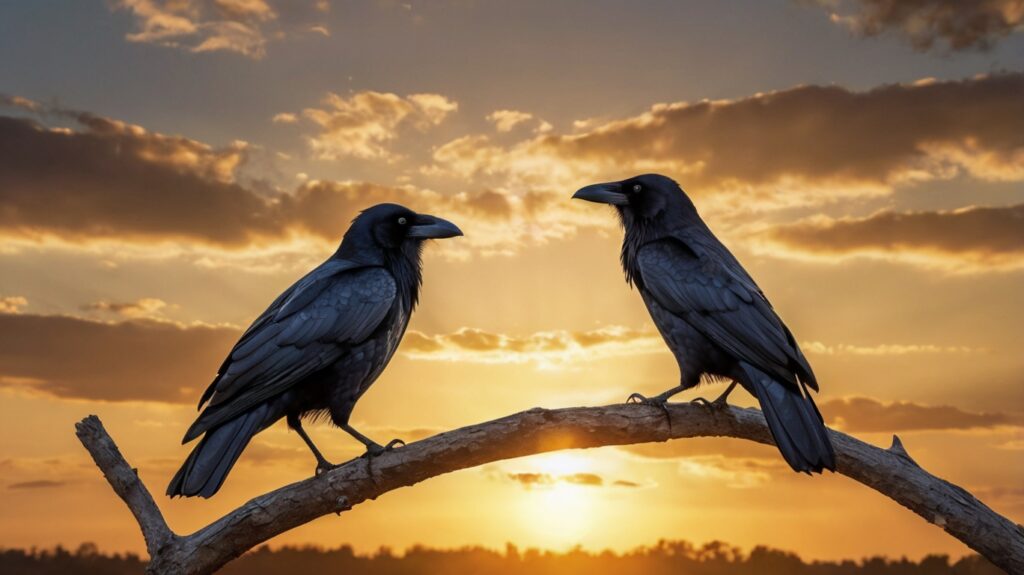
As we conclude our exploration of the captivating world of crows and ravens, it’s clear that these birds are more than just fascinating creatures; they are a testament to the complexity of nature and the remarkable intelligence that exists within the animal kingdom. From their distinct physical characteristics and intricate social behaviors to their cultural significance and myths, crows and ravens embody a rich tapestry of traits that have inspired and intrigued humans for centuries. Their ability to adapt, solve problems, and interact with their environment in unique ways highlights the importance of preserving their habitats and understanding their roles in ecosystems.
The rich cultural narratives and folklore surrounding these birds serve as a reminder of the deep connections between humanity and the natural world. As we continue to learn about their intelligence and behaviors, it is essential to foster a sense of appreciation for these remarkable avians. Their presence in our lives, whether in urban areas or rural landscapes, enriches our experiences and deepens our understanding of the complexities of nature.
Ultimately, crows and ravens invite us to observe and appreciate the beauty of the world around us. By taking the time to learn more about these intelligent birds and advocating for their conservation, we contribute to a greater appreciation of the diverse species that share our planet. So, whether you are a seasoned birdwatcher or a casual observer, the next time you encounter a crow or a raven, take a moment to admire their grace, intelligence, and the mysteries they hold within their wings.

